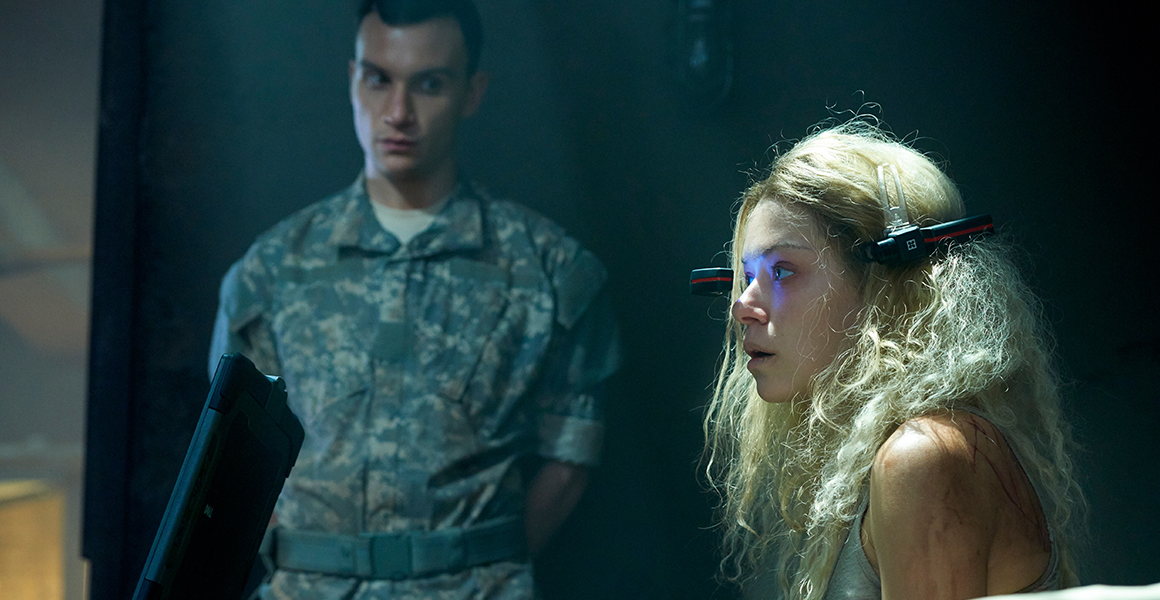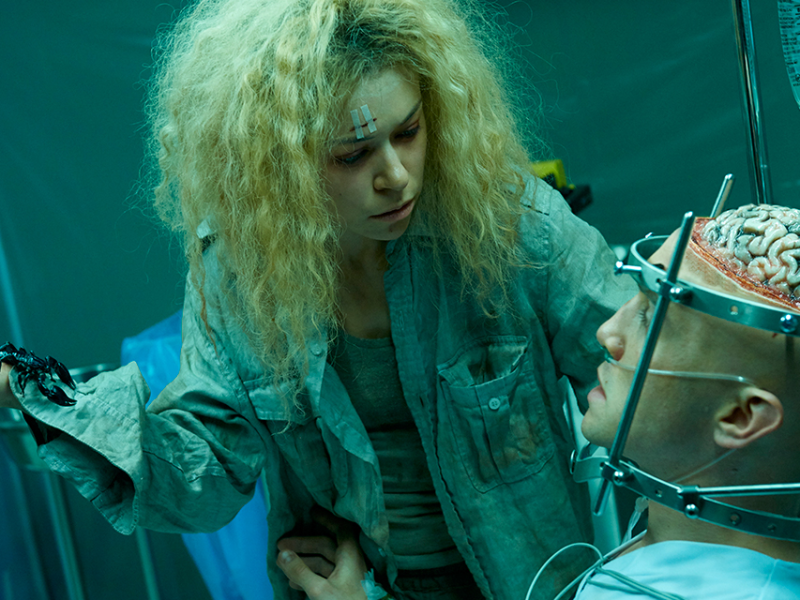So far, this series on the science behind Orphan Black has made a number of conclusions, or should I say clone-

But alas, all of these scientific clone-siderations, errr, considerations may be legally moot. If you want to make a clone in 2015, you’ve got to be willing to break quite a few laws (though I’m not sure that’s a problem for the Dyad Institute or the even more unscrupulous Topside). Throughout the course of the first two seasons we learn that Sarah Manning (Tatiana Maslany) and her continually revealed brood of sisters are all property of Dyad—in fact, it is literally watermarked into their DNA, as verified by Cosima and her then lab partner and future boss Delphine (Evelyne Brochu). After the duo decodes some the synthetic sequence in the season 1 finale (Endless Forms Most Beautiful), they reveal a startling hidden message: “This organism and derivative genetic material is restricted intellectual property.” Worldwide abolition of slavery aside, can you own a human clone? More broadly, can a person be intellectual property? For that matter, can any biological entity be considered intellectual property? Oh yeah, and is cloning even legal?
The answers to these questions, like all legal questions of course, vary among the nations of the earth. While the Orphan Black storyline has been restricted to Canada—though who the heck knows what extradition-treaty-lacking wasteland the Project Castor clones have abducted Helena and Sarah (?!) to—a large portion of both the show’s viewers and clones live within other legal jurisdictions. Accordingly, let’s take a broad look at some of the variation in intellectual property rights of biological materials.
Copyrights, trademarks, and patents
_members_world_map.svg/1000px-World_Intellectual_Property_Organization_(WIPO)_members_world_map.svg.png)
In Canada, the United States, and the rest of the developed world, ownership is not restricted to physical entities. Put another way, it is possible to own ideas. Generally speaking, such intellectual property protections fall into three categories: copyrights, which prohibit duplication of creative works like music and text; trademarks, which permit differentiation of commercial brands; and patents, which protect exclusive use or production of inventions. More importantly, we can focus on patents hereafter because when we are talking about intellectual property rights in the context of novel life forms and genes, logic dictates that we are talking about patents and not copyrights or trademarks (it is hard to compare a synthetic genome to a sonnet or clone’s face to the Nike swish). While the specific protections of these categories of intellectual property differ globally, the categorizations are fairly consistent. Additionally, all countries permit the patenting of processes, unless a type of process is explicitly forbidden. That is, if you have a special technique for producing clones, you should check cloning laws and start submitting patent applications immediately.
Patenting genes in the EU
Because most of the Project Leda clones we’ve learned about so far were born (and conceived) in the European Union, it makes sense to familiarize ourselves with patenting life forms in the EU. Since 1998, under European Parliament directive 98/44/EC, you can patent just about any darn biological entity with a little imagination, though there are a few germane exceptions. For example, 98/44/EC permits the patenting of any gene produced by any organism—including humans—whether it’s created in a lab or found in nature, as long as there is a novel application or method involved. In other words, if you and I were to use traditional methods to breed a new type of chicken, we could patent that chicken and/or its genes if the organism has a novel genetic makeup or its genes carry out a specific function. Furthermore, the protections afforded to those who develop plant breeds are even broader; in Europe, one can apply to the Community Plant Variety Office for patent-like protection of nearly any breed developed.
However, 98/44/EC also specifically forbids human cloning and expressly rules out intellectual property rights surrounding human cloning methods or technology. Ultimately, when any Project Leda or Castor clone is within the EU, even genetically watermarked intellectual property claims are invalid.
While all clone-related matters are verboten in Europe, any gene can be patented in the EU, and this gene patentability has the potential to impact real world lives on a daily basis. Directive 98/44/EC explicitly permits patenting human genetic material. As such, genetic tests that scan genomes to find specific faulty gene copies can be patented regardless of the methods used, and patent infringement therefore leaves one vulnerable to civil litigation. The funny thing is, in the UK, few patent holders appear to take action against infringers; the UK National Health Services (NHS) runs its own genetic tests on plenty of patented genes without any resistance from patent holders. Moreover, NHS is provided inexpensive access to patented clinical diagnostics. Similarly, EuroGenTest laboratories spread across Europe operate in ignorance of the intellectual property status of the genes they test on a daily basis. For the time being, the socialized healthcare of Europe may have kept gene patent litigation at bay there.
Patenting genes in the US
What about biological patents in the United States? Well, things are a little different “across the pond.” First, many, many, many more patents are filed in the United States, and genes have traditionally been no exception. It was only a matter of time until American jurisprudence was forced to weigh in. In spring of 2013, the US Supreme Court heard Association for Molecular Pathology v. Myriad Genetics and unanimously ruled that human genes are unpatentable as they are products of nature. In this case, a broad swath of plaintiffs, including major research universities, advocacy groups, and even patients, alleged that the BRCA1 and BRA2 gene patents owned by Myriad Genetics were invalid. As faithful readers of this series may remember, mutant copies of BRCA1 and BRCA2 dramatically increase the risk of developing breast and ovarian cancer. Results of genetics tests like those performed by Myriad Genetics are what prompted actress Angelina Jolie to undergo a precautionary double mastectomy—so clearly these tests are pretty important.
The ACLU attorneys representing the plaintiffs did not argue that the importance of these genetic tests overruled the validity of these patents; rather, they successfully argued that genes, as products of nature, are unpatentable under case law interpretation of Title 35 of the US Code. The opinion, penned by Justice Clarence Thomas, unequivocally rules that “A naturally occurring DNA segment is a product of nature and not patent eligible merely because it has been isolated.” And in a flash, Myriad Genetics lost its exclusive right to screen breast cancer genes and literally thousands of other gene patents were null and void. Case closed; genes, human or otherwise, cannot be intellectual property, right?
Not quite—the synthetic sequences found in the Leda and Castor clones’ DNA are a whole different matter. The very same Supreme Court case specifically affirms patent protection for cDNA, which stands for “complementary DNA” and is a synthetic DNA copy of a piece of RNA. As Justice Thomas puts it, “The lab technician unquestionably creates something new when cDNA is made.” Simply put, when a lab technician “creates” cDNA he or she is making a mirror-image copy of RNA, which is itself a mirror-image copy of genomic DNA (see last week’s post and its primer on the Central Dogma of Molecular Biology for more details). Copying is probably the least creative way of, well, creating something. As such, the bar for what constitutes patentable genetic material is as low as imaginable, and a synthetic sequence in a human clone’s genome absolutely exceeds that bar. So does Dyad’s claim on Sarah and her sisters hold water in the US of A?
Because there are no US federal cloning laws, that depends on the S of A in which one finds oneself. In Minnesota, where Cosima was going to grad school, human reproductive cloning is unregulated, but in 13 out of the other 49 states, her inception would have been a crime. On a state-by-state basis, cloning is approximately 6 times more legal in the United States than marijuana, and if you can make a clone with any synthetic DNA at all, the US Federal Government will protect your rights to owning the information in your clone’s DNA.
Patenting genes in Canada
But what about Canada, where Orphan Black actually takes place? While its neighbor to the south is more typically known for its historically lawless frontier, Canada is the modern Wild West of human gene patenting. Legislation and legal precedent is limited. In 2004, the Supreme Court of Canada affirmed in Monsanto v. Schmeiser that modified genes are patentable, much like the US Supreme Court eventually found in the Myriad Genetics case. However, as of 2015 court documents are currently being filed to determine if unmodified human genes are fair game.
The claimant in this case is the Children’s Hospital of Eastern Ontario. Simply put, they want to freely use nonproprietary, targeted gene sequencing as well as full genomic sequencing to determine if patients are genetically predisposed to disorders such as long QT syndrome, which is a dangerous heart arrhythmia condition they cite in their court filings. At this point, Canada could fall in line with the EU or the US on this matter. They may permit human gene patents or renounce current human gene patents—only time will tell.
But until then, don’t bother trying to clone humans in Canada. In 2004, Canadian Parliament passed the Assisted Human Reproductive Act, which outright bans human cloning. I guess the Dyad Institute should move its headquarters? (I hear Buffalo is lovely this time of year, and New York permits cloning.)
So where can you clone humans and own their genes?
If you want to start your own sinister research institute, pick your locale wisely. You can’t clone humans in Canada or the EU, even though you can own genes, but you can clone humans in most of the US and also own synthetic genes. In Florida, for example, not only could you hypothetically make a clone, but you could also sue someone for creating similar clones.
But remember, if Dyad was making carbon copy babies in the mid 1980’s, they were not in violation of any contemporary laws. Until Dolly the cloned Sheep made waves, human cloning bans were restricted to science fiction, and I imagine Projects Leda and Castor took full advantage of that. But what about the products of these projects? That is, what legal action should clones take to ensure their freedom from Dyad and Topside?
What rights do clones have?
While no jurisdictions explicitly regard clones as persons, most decent constitutional lawyers would probably argue for the personhood of Sarah, Alison, Cosima, and their sisters as well as Orphan Black Wikia - Mark Rollins, Orphan Black Wikia - Rudy, and their brethren (Ari Millen - IMDb). The quickest and easiest way to do this in Canada and the United States is to use the Canadian Citizenship Act of 1946 and Fourteenth Amendment to the US Constitution, respectively. These two pieces of legislature ensure that anyone born in each of these nations is a native-born citizen regardless of any other circumstances.
Things are trickier in the EU, where the expansive Charter of Fundamental Rights of the European Union could certainly protect the freedom of Leda and Castor clones if they are citizens of EU member states, which is a little more complicated (nifty table here). Some countries, like Poland, operate exactly like the US and Canada with respect to birthright citizenship, but other nations have complicated parentage laws. Ultimately, the best course of action for a Euro-clone in the eurozone would be to find a very good lawyer, or perhaps shell out a mere £150,000 (
Check some of our other articles
- Can the 'Orphan Black' Project Castor prions be an STD?
- Can Kira's stem cells save Cosima in 'Orphan Black'?
- Can clones in 'Orphan Black' fall on different parts of the sexuality spectrum?




